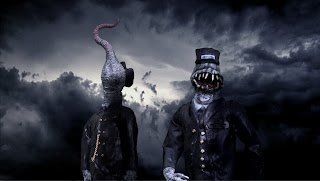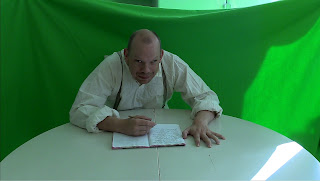If you recently watched my YouTube film "The Thing In the Moonlight" you probably remember these guys. They're both stop-motion puppets, and very simple ones at that, but they do have one innovation (for me, at least.)
The monsters are supposed to be dressed in the 1920's uniforms of a street car motorman and conductor. Googling up images of these garments I quickly realized that I would never be able to sew these uniform using cloth and thread. Instead I opted to simply sculpt them in clay. I say "simply" since that is a creative medium I am very familiar with. I used Monster Clay Soft to sculpt the whole upper portion of each uniform, which includes a coat, a vest, a shirt and a tie.
A dark blue-grey tint was added to the latex, which was then painted into each plaster mold half using a pipe cleaner. The halves were then closed, and more latex poured into the mold and slushed around to build up a thickness to the "skin" of the clothes.
I started with sculpting the clothes just because it was convenient, then building the puppets to fit the latex clothes skins. The head of the motorman is supposed to be featureless, except for having a tapering tentacle. The bulbous head was simply a wooden ball into which a piece of aluminum wire was stuck. Soft yarn and tinted latex built up the fleshy shape of the tentacle, while cotton and latex was used as a covering over the wooden ball. Aluminum wires created a neck joint and thin polyurethane sheets were wrapped around the wires. Very simple stuff, in other words.
The conductor was supposed to start running on all fours, which suggested a distinctly animal-like quality. I sculpted a big toothy mouth for the character, but little else in the way of a face.
Only the front of the head was sculpted, and a simple one-piece mold was created over the sculpture. Since it was an open mold a thick latex skin for the face was quickly built up, using a hot air gun to make the latex vulcanize faster.
More soft polyurethane sheets were used to build up bulk on the basic aluminum wire armature. Since the body was going to be covered with the latex clothes I knew I didn't have to spend too much on detail, though it was important to make the foam fill out the clothes in a proper way.
The teeth were small bits of cotton rolled in latex and allowed to dry before attaching them to pits in the gums using more latex.
Both puppets had additional detailing added using small patches of cast latex skin textures. Latex tinted a greyish green was then dry brushed over the wrinkly surface of the skins with a small bit of foam sponge. Claws were cut out of white cardboard, and then covered with liquid latex.
The pants were simply pulled on each puppet, but in order to get the top half on I had to cut the vest open. It was then a simple matter of closing it again with a string of liquid latex.
As you can see in this photo one arm is longer than the other on the coat. That's simply because I was careless, and carried on building the puppets without measuring their arms to the jacket size. To fix this I cast a pair of extra pants and attached the legs as new coat arms.
To distinguish the two sets from each other I left the conductor's coat open and closed the motorman's. The two uniforms also had some additional features, such as extra pockets placed in different places. These, and other small details, were created by cutting out shapes in soft thick paper, dipping them in tinted latex and sticking them to the coats.
To create a creepy otherworldly look to the costumes, giving them the feel that they're not quite right, I painted them with tinted latex. This created a shiny wet look that made the characters look like they had just climbed out of a swamp, or something. A small clock chain, pulled from old brass jewellery, was attached to the motorman's outfit and all the buttons were painted with acrylic gold colors. The hats, also cast in latex, were stuck on with liquid latex as a bonding agent.




































